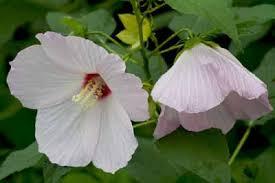Printed at http://www.newmoonnursery.com/index.cfm/
Hibiscus moscheutos
Swamp mallow
Native to North America
FIRST IMPRESSIONS: Hibiscus moscheutos is a statuesque perennial with large leaves and many sturdy vertical stems. In summer, plants are crowned by striking saucer shaped flowers. The solitary blooms are located in the upper leaf axils and are usually white with a crimson center. This species thrives in sunny moist or wet sites where it is sought after by many pollinators.
HABITAT & HARDINESS: Hibiscus moscheutos occurs from Ontario to Massachusetts and Florida and west to Wisconsin and Texas. The greatest distribution is in Louisiana with plants occurring in almost every parish.
Plants are indigenous to ditches, edges of brackish or freshwater swamps, marshes, wet prairies and low soggy margins of rivers or ponds. Large impressive stands sometimes occur.
Hardy from USDA Zones 5-8.
PLANT DESCRIPTION: Hibiscus moscheutos is a robust shrubby wildflower with multiple upright stems.
The stems are glabrous or pubescent and are clothed in bold ovate toothed leaves. Blades are usually unlobed but can have 2 lateral lobes. The leaf surface is grayish green and fairly smooth with lighter colored pubescent undersides.
From summer until early autumn spectacular funnel-form or saucer shaped flowers are borne in the upper leaf axils. Blooms are 4-12” across with 5 lustrous overlapping petals. Flowers are commonly white with a crimson eye and occasionally pure white, pink or rose colored.
Each bloom lasts only a day but they are produced repeatedly for about a month and are followed by 1-2” capsules.
Plants are 4-7’ tall with a spread of 3-4’.
CULTURAL & MAINTENANCE NEEDS: Hibiscus moscheutos prefers sunny exposures with rich wet to moist soils.
Plants are fairly drought tolerant after establishment. They also tolerate clay, muck and shallow standing water.
Stems are sturdy and rarely need staking. They are generally cut to the ground in late winter allowing their angular capsules to provide winter interest.
Young plants are occasionally nibbled by deer. This cotton relative is also attacked by Japanese beetles and by sawfly larva which skeletonize the leaves. If pests are a problem, seek organic controls that will not harm beneficial pollinators.
LANDSCAPE USES: Due to the Showy Blooms, Hibiscus moscheutos is a dramatic Accent, Grouping or Mass for a Wildlife Garden or Water Garden. Plants are also used in Containers, as Butterfly Nectar Plants and in Cottage Gardens, Rain Gardens, Water-wise Landscapes, Low Maintenance Plantings, Perennial Borders, Roadsides and Wetlands.
COMPANION & UNDERSTUDY PLANTS: Try pairing Hibiscus moscheutos with Asclepias incarnata, Eupatorium fistulosum, Helianthus angustifolius, Lobelia cardinalis and Panicum virgatum.
Hibiscus coccineus is a worthy substitute with similar flowers and cultural needs.
TRIVIA: The exotic appearing supersized flowers are pollinated by native long tongued bees including the specialist Rose Mallow Bee. Blooms provide nectar to ruby throated hummingbirds and a variety of insects. Plants host caterpillars of gray hairstreak, painted lady butterflies, skippers and several moths including the Io Moth and Delightful Bird-Dropping Moth.
Flowers consistently open between 9:00 and 11:00 a.m. EST. Due to this, Hibiscus moscheutos was used in a floral clock created at the New York Botanical Garden.
Pink forms of Hibiscus moscheutos that lack the crimson center were once classified as Hibiscus palustris. Currently these plants are considered to be simply a color form of Hibiscus moscheutos.
Sometimes known as Crimson-eyed Rose Mallow and Wild Cotton.
Height:
4-7 ftSpread:
3-4 ftSpacing:
3-6 ftUSDA Hardiness Zone:
5-8Bloom Color:
Pink, WhiteHibiscus moscheutos Characteristics
Attracts Wildlife
- Pollinators
- Hummingbirds
- Butterflies
Attributes
- East-Coast Native
- Coastal
- Rain Garden
- Bog
- Reblooming
- Long Blooming
Exposure
- Full Sun
Deer Resistant
- Deer Resistant
Flowering Months
- September
- August
- July
Foliage Color
- Green
Growth Rate
- Fast
Salt Tolerance
- Low
Season of Interest (Foliage)
- Summer
Soil Moisture Preference
- Wet to Moist
Interesting Notes:
For more information on this plant, visit the USDA PLANTS Database: http://plants.usda.gov/java/profile?symbol=HIMO

